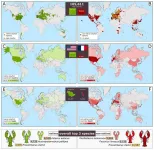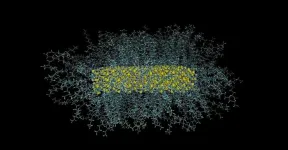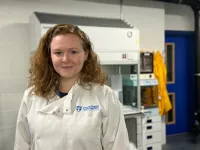Ancient 3D paper art, kirigami, could shape modern wireless technology
2024-10-14
The future of wireless technology — from charging devices to boosting communication signals — relies on the antennas that transmit electromagnetic waves becoming increasingly versatile, durable and easy to manufacture. Researchers at Drexel University and the University of British Columbia believe kirigami, the ancient Japanese art of cutting and folding paper to create intricate three-dimensional designs, could provide a model for manufacturing the next generation of antennas.
Recently published in the journal Nature Communications, research from the Drexel-UBC team showed how kirigami — a variation of origami — ...
Integrating machine learning with statistical methods enhances disease risk prediction models
2024-10-14
Researchers from Peking University have conducted a comprehensive systematic review on the integration of machine learning into statistical methods for disease risk prediction models, shedding light on the potential of such integrated models in clinical diagnosis and screening practices. The study, led by Professor Feng Sun from the Department of Epidemiology and Biostatistics, School of Public Health, Peking University, has been published in Health Data Science.
Disease risk prediction is crucial for early diagnosis and effective clinical decision-making. However, traditional statistical models, such as logistic regression and Cox proportional hazards regression, often ...
Changing watering practices to improve tomato plant health
2024-10-14
Some people believe that talking to your plants makes them thrive. While there’s limited scientific support for sound improving plant health, there’s a growing amount of evidence about the benefits of mechanical stimulation, like touch, wind or rain. Researchers reporting in ACS’ Journal of Agricultural and Food Chemistry examined the impact of watering practices on tomato plants. They found that the size of the water droplets affected plant growth and resistance to pests and pathogens.
Climate change threatens crop production as rising ...
Six proteins implicated in early-onset preeclampsia
2024-10-14
Preeclampsia is a life-threatening pregnancy complication marked by persistent high blood pressure that is even more serious when it occurs early in the first trimester. The exact cause of early-onset preeclampsia is unknown, and it is difficult to predict, prevent and diagnose. Now, in ACS’ Journal of Proteome Research, researchers report on six proteins that could be used as targets to diagnose and treat the condition.
Preeclampsia’s key symptom is high maternal blood pressure, and serious cases can lead to maternal organ failure, low infant birth weight, or maternal or fetal death. ...
Researchers at The University of Texas at San Antonio reveal oversight in AI image recognition tools
2024-10-14
Artificial intelligence can help people process and comprehend large amounts of data with precision, but the modern image recognition platforms and computer vision models that are built into AI frequently overlook an important back-end feature called the alpha channel, which controls the transparency of images, according to a new study.
Researchers at The University of Texas at San Antonio (UTSA) developed a proprietary attack called AlphaDog to study how hackers can exploit this oversight. Their findings are described in a paper written by Guenevere Chen, an assistant professor in the UTSA Department of Electrical and Computer Engineering, and her former ...
World of crayfish™: A web platform for global mapping of freshwater crayfish and pathogens
2024-10-14
Freshwater crayfish, keystone species of aquatic ecosystems, are now at the center of a new tool that promises to revolutionize conservation efforts. World of Crayfish™ (WoC), a newly launched web platform, aims to provide real-time global mapping of freshwater crayfish and their pathogens, offering an invaluable resource for researchers, conservationists, and environmental stakeholders.
Published in PeerJ Life and Environment, the article, World of Crayfish™: A web platform towards real-time global mapping of freshwater crayfish and their pathogens, highlights the urgent need for accurate, up-to-date data on ...
How to make biodiversity credits work: science-based solutions for real conservation gains
2024-10-14
Biodiversity is in crisis. Human activities are driving species extinctions at unprecedented rates, but funding for conservation remains woefully inadequate. To address this gap, the concept of a Biodiversity Credit Market (BCM) has emerged, inspired by carbon credit systems that incentivize conservation and restoration efforts.
However, while the BCM holds promise, it risks falling into the same pitfalls as its carbon counterpart—especially if it fails to implement rigorous science-backed baselines, ...
Qunova becomes first to achieve ‘chemical accuracy’ on commercial quantum computers with its hardware agnostic algorithm
2024-10-14
DAEJEON, South Korea (October 14, 2024) – Qunova Computing, a developer of quantum software applications designed to bring quantum computing to the chemical, pharmaceutical and industrial engineering industries, today announces the results from a series of recent tests performed on three different NISQ era quantum computers, each with a different qubit count. In each demonstration, Qunova’s algorithm was able to produce results with accuracy below the threshold of 1.6 millihartrees required for real-world quantum chemistry applications, a level known as ‘chemical ...
Scientists have successfully bred corals to improve their heat tolerance
2024-10-14
Scientists have successfully bred corals to improve their heat tolerance
A new study has shown that selective breeding can lead to a modest rise in coral heat tolerance.
Led by experts at Newcastle University’s Coralassist Lab, the study documents the world’s first effort to selectively breed adult corals for enhanced heat tolerance, i.e. the ability of adult corals to survive intense marine heatwaves. The breeding effort was a success, showing that it is possible to improve the heat tolerance of adult coral offspring, even in a single generation.
However, the improvement was modest in comparison ...
Adaptability of trees persists after millions of years of climate change
2024-10-14
Seven of the most common forest trees in Europe have been shown to be able to shelter their genetic diversity from major shifts in environmental conditions. This is despite their ranges having shrunk and the number of trees having fallen sharply during ice age cycles. These are the findings of a study by a European consortium including Uppsala University, published in Nature Communications.
“From a biodiversity perspective, this is very positive because these trees are keystone species on which many other species depend,” says Pascal Milesi, Associate Professor of Plant Ecology and Evolution at Uppsala University and first author of the study.
The researchers aimed to investigate ...
Protein involved in balancing DNA replication and restarting found
2024-10-14
A protein that is involved in determining which enzymes cut or unwind DNA during the replication process has been identified in a new study.
In a new paper published in Nature Communications, an international team of researchers have found that the protein USP50 supports the DNA replication process by helping to decide the proper use of nucleases or helicases. These enzymes are implemented during the DNA replication process to promote ongoing replication and where the copying machinery runs into problems ...
How liberals and conservatives can have better conversations, according to a psychologist
2024-10-14
Bridging Our Political Divide collects the insights of a psychologist who offers antidotes to the unproductive arguments that now dominate our political culture and ways to find common ground.
New York, U.S./Oxford, UK, October 14, 2024 – As the 2024 US Presidential Election in November inches closer, the partisan divide in American society has never felt more apparent – or pervasive.
From workplace chatter to heated discussions at family gatherings, many Americans may have asked themselves, ‘How can I make this ...
Survey finds 25% of adults suspect they have undiagnosed ADHD
2024-10-14
COLUMBUS, Ohio – Attention deficit/hyperactivity disorder – also known as ADHD – is typically thought of as a childhood condition. But more adults are realizing that their struggles with attention, focus and restlessness could in fact be undiagnosed ADHD, thanks in large part to trending social media videos racking up millions of views.
A new national survey of 1,000 American adults commissioned by The Ohio State University Wexner Medical Center and College of Medicine finds that 25% of adults now suspect they may have undiagnosed ADHD. But what worries mental health experts is that only 13% of survey respondents have shared their suspicions with their doctor.
That’s ...
Let there be light: Bright future for solar panels, TV screens and more
2024-10-14
From brighter TV screens to better medical diagnostics and more efficient solar panels, new Curtin-led research has discovered how to make more molecules stick to the surface of tiny nanocrystals, in a breakthrough that could lead to improvements in everyday technology.
Lead author Associate Professor Guohua Jia from Curtin’s School of Molecular and Life Sciences, said the study investigated how the shape of zinc sulfide nanocrystals affected how well molecules, known as ligands, stick to their surface.
“Ligands, play an important role in controlling the behaviour and performance ...
Innovative nanoparticle therapy targets fat absorption to combat obesity
2024-10-13
(Monday 14 October 2024, Vienna, Austria) Researchers have unveiled a novel approach to tackle obesity by targeting fat absorption in the small intestine. The cutting-edge nanoparticle system, engineered to deliver therapeutic molecules directly to the digestive tract, has shown significant potential to prevent diet-induced obesity.1,2
Presented today at UEG Week 2024, the study focuses on an enzyme called Sterol O-acyltransferase 2 (SOAT2), which plays a critical role in fat absorpsion in the small intestine.3,4 By inhibiting this enzyme in the small intestine, the study offers a promising therapeutic approach to reduce fat absorption ...
Novel procedure combined with semaglutide may eliminate insulin dependency in type 2 diabetes
2024-10-13
(Monday 14 October 2024, Vienna, Austria) Groundbreaking research presented today at UEG Week 2024 reveals a promising new treatment strategy for type 2 diabetes (T2D) that could significantly reduce or even eliminate the need for insulin therapy.1
This innovative approach, which combines a novel procedure known as ReCET (Re-Cellularization via Electroporation Therapy) with semaglutide, resulted in the elimination of insulin therapy for 86% of patients.
Globally, T2D affects 422 million people, with obesity recognised as a significant ...
Three key signs of major trauma could speed up treatment of severely injured children brought to emergency departments by carers not ambulances
2024-10-13
Copenhagen, Denmark: Severely injured children who are brought to an emergency medical department by their parents or carers are often not seen as quickly as those who arrive at hospital via ambulance, according to findings presented at the European Emergency Medicine Congress today (Monday). [1]
The study’s researchers identified three key trauma features that should prompt doctors to review these patients immediately and potentially prioritise their treatment: boggy swelling to the head, abdominal bruising, and thigh swelling or deformity.
The study was carried out in an inner-city ...
Climate change is a health emergency too
2024-10-13
Copenhagen, Denmark: International experts in emergency medicine have warned that climate change is likely to have a severe impact on emergency services around the world. Despite this, few countries have assessed the scale of the impact or have a plan to deal with it.
In a special session at the European Emergency Medicine Congress today (Sunday), Luis Garcia Castrillo, a professor in emergency medicine, now retired, at the Hospital Marqués de Valdecilla, Santander, Spain, described how he and colleagues from EUSEM’s Emergency Medicine Day working group had asked 42 focus groups, consisting of experts in emergency medicine, prehospital care ...
Chronic stress accelerates colorectal cancer progression by disrupting the balance of gut microbiota, new study shows
2024-10-12
(13 October 2024, Vienna, Austria) Cutting-edge research has uncovered how chronic stress disrupts the balance of gut microbiota to speed up the progression of colorectal cancer (CRC), opening new avenues for CRC prevention and treatment.1
By eliminating certain gut bacteria and inducing stress, researchers were able to conclude a relationship between stress and gut microbiota in the progression of CRC, identifying a particular bacterial species as a potential therapeutic target.
Presenting the study at UEG Week 2024, lead researcher Dr Qing Li explained, “In our study, we used an antibiotic ...
Brazilian study identifies potential targets for treatment of visceral leishmaniasis
2024-10-11
Researchers at the Federal University of São Carlos (UFSCar), the State University of Campinas (UNICAMP) and the University of São Paulo (USP) in Brazil have characterized for the first time a class of proteins present in the parasite Leishmania infantum and involved in regulating its cell cycle. In an article published in PLOS Pathogens, they describe potential pharmaceutical targets for the treatment of visceral leishmaniasis. Existing therapeutic strategies are considered insufficiently effective.
In eukaryotic organisms, which have cells with a defined nucleus and include all plants and animals, the ubiquitin-proteasome system (UPS) ...
Using AI and iNaturalist, scientists build one of the highest resolution maps yet of California plants
2024-10-11
With the help of deep learning, University of California, Berkeley, scientists have leveraged citizen science data from the app iNaturalist to create the highest resolution maps yet of plant distributions throughout California.
iNaturalist is a widely-used cellphone app, originally developed by UC Berkeley students, that allows people to upload photos and the location data of plants, animals or any other life they encounter and then crowdsource their identity. The app currently has more than 8 million users worldwide who collectively have uploaded more than 200 million observations.
The researchers used a ...
Researchers identify signs tied to more severe cases of RSV
2024-10-11
Respiratory syncytial virus (RSV) is the leading cause of hospitalization in young children due to respiratory complications such as bronchiolitis and pneumonia. Yet little is understood about why some children develop only mild symptoms while others develop severe disease. To better understand what happens in these cases, clinician-scientists from Brigham and Women’s Hospital, a founding member of the Mass General Brigham healthcare system, and Boston Children’s Hospital analyzed samples from patients’ airways and ...
Mays Cancer Center radiation oncologist recognized as outstanding mentor to next generation leaders
2024-10-11
SAN ANTONIO, Oct. 11, 2024 – David Gius, MD, PhD, professor in the Department of Radiation Oncology and assistant dean of research at The University of Texas Health Science Center at San Antonio (UT Health San Antonio), was named this year’s recipient of the prestigious American Society for Radiation Oncology (ASTRO) Career Recognition Mentorship Award.
Gius is associate cancer center director for translational research at Mays Cancer Center at UT Health San Antonio. He is among three awardees receiving this recognition. The award honors individuals who have made significant contributions to mentorship ...
Hitting the bull’s eye to target ‘undruggable’ diseases – researchers reveal new levels of detail in targeted protein degradation
2024-10-11
Hitting the bull’s eye to target ‘undruggable’ diseases – researchers reveal new levels of detail in targeted protein degradation
Targeted protein degradation has opened up a new field of drug discovery with potential to treat previously ‘undruggable’ diseases
Dundee researchers have revealed new levels of details of how protein degraders work
The work means new drugs can be much more accurately targeted at the molecular level, creating and hitting a metaphorical ...
SCAI publishes expert consensus statement on managing patients with ST-elevated myocardial infarction
2024-10-11
WASHINGTON —The Society for Cardiovascular Angiography & Interventions (SCAI) is pleased to announce the publication of the Expert Consensus Statement on the Management of Patients with STEMI Referred for Primary PCI.
Published in JSCAI, the consensus statement provides detailed suggestions for clinicians, particularly for nuanced situations not covered by general guidelines. It highlights the strengths and limitations of various diagnostic and therapeutic interventions for treating patients with STEMI, provides ...
[1] ... [755]
[756]
[757]
[758]
[759]
[760]
[761]
[762]
763
[764]
[765]
[766]
[767]
[768]
[769]
[770]
[771]
... [8701]
Press-News.org - Free Press Release Distribution service.












